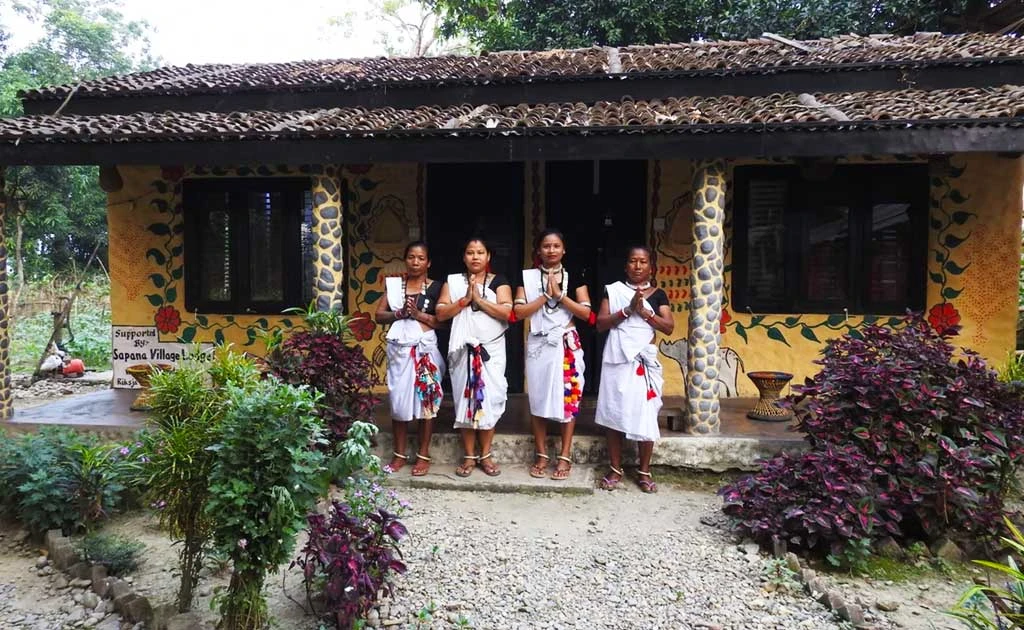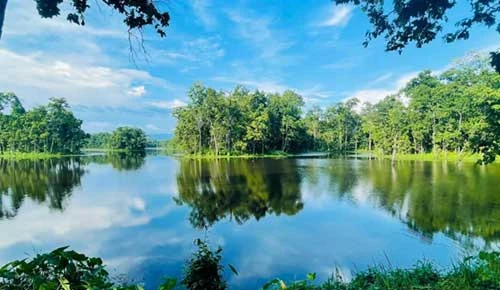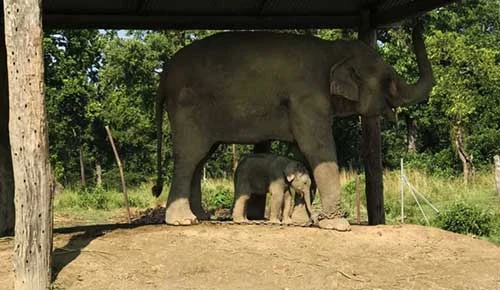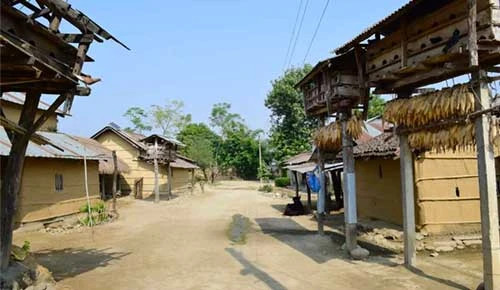Tharu Village Travel Guide
The Nepali Tharu villages are a great place to experience the colorful lifestyles and warm hospitality of the Tharu community, one of the oldest and most vibrant ethnic groups in the country. These villages, which are primarily distributed in the Terai region, are culture, lifestyle, and heritage museums in the form of living.
A visit to a Tharu village enables travelers to get out of the normal trekking trails and see another Nepal. Their unique houses made of mud and thatch, the colorful mode of dressing, folk dances, and ancient traditions reflect local people whose lives are in touch with nature and the land. Not only looking around, a trip to a Tharu village is a matter of socializing, sharing meals, listening to stories, and learning about their struggle and customs. It is a true cultural experience that goes very well with jungle safaris and wildlife escapades in the lowlands of Nepal.
Why Visit Tharu Village?
Cultural Experiences: A Tharu Village is such a museum of life, where people still stick to customs in their lives. They are able to observe colorful folk dances, enjoy the sounds of folk songs, and watch the artistic houses with mud plaster and colorful motifs in their decoration. Such cultural performance is not a show in front of the tourists but an original set of practices that were being transmitted to generations, and the experience is thus true and valuable.
Authentic Lifestyle Experiences: Engaging with a Tharu Village will provide guests with a genuinely authentic expression of rural life. For example, traveling across an open view to take in the farmlands, learn the methods of fishing, see how locals use what are natural resources for their everyday needs, etc. There are no idle people; there are opportunities for families to invite visitors to engage in, observe, and participate in cooking, weaving, or providing some labor in the fields or elsewhere within the community context.
Scenic Surroundings: The village is surrounded by beautiful nature, with huge fields of mustard that turn yellow at the end of winter or rice fields in the planting season that shine because they are irrigated from reservoirs, which are able to represent the borderless beauty. The village is surrounded by beautiful nature, with huge fields of mustard that turn yellow at the end of winter or rice fields in the planting season that shine because they are irrigated from reservoirs, which are able to represent the borderless beauty. The beautiful villages, cozy homes set against stunning scenery, and the colorful clothing of the Tharu people always draw visitors. Some come to enjoy the peace, while others can’t resist capturing the vibrant moments on camera.
Distinctive Food: Food is a key part of culture. Tharu food is unique and possesses its own flavor. Examples include dhikri cores of steamed rice flour, which are dumplings and would be consumed during festivals and ghonghi (a dish of snails found in the river). These are the dishes that depict the creativity and proximity of the Tharu culture to the water and earth; the traditional technique that will make you be in touch with the people and land. Trying these dishes made with local ingredients are not just tasty; they’re a fun and unforgettable way to experience Tharu culture.
How to Reach Tharu Village?
Accessing a Tharu village is simple and enjoyable, especially since many of them are located close to popular destinations like Chitwan and Bardiya National Parks.
- By Taxi or Privately Hired Vehicle: From Bharatpur or Sauraha (near Chitwan National Park), a short 20–30 minute drive will take you directly to nearby Tharu settlements. Hiring a private vehicle makes the trip comfortable and flexible, especially if traveling with family.
- By Local Bus or Jeep: Local buses and shared jeeps run regularly from Bharatpur, Narayanghat, or nearby towns to villages around Chitwan and Bardiya. This is the most economical option, and it also gives travelers a chance to experience local commuting.
- On Foot: If you are staying near the national parks, some Tharu villages are within walking distance. A guided village walk is a popular option, allowing you to explore trails, enjoy the natural surroundings, and interact with locals on the way.
Best Time to Visit Tharu Village
Spring (March to May)
Spring is basically a cool and lively season, which makes it quite a nice time to go through Tharu culture. In the daytime, the temperature is usually between 25°C and 34°C, and at night it goes from 15°C to 22°C. The climate is very comfortable for riding bikes through the villages, visiting the lands for agriculture, and taking part in the evening cultural dances. Apart from that, the fields are newly sown, and you can watch the Tharu people get ready for the planting season.
Summer/Monsoon (June to August)
Heavy rain is typical of this period alongside high humidity and beautiful green surroundings. 28°C to 36°C is the range of the daytime temperatures, and at night it stays around 22°C to 26°C. The monsoon, however, with all its muddy tracks and violent showers, is still bringing life to the rivers and woods; hence, everything is getting lush. Moreover, if you think the rain is not an issue, then you can have a look at the traditional farming practices and breathe in the freshness of the Tharu settlements.
Autumn (September to November)
The most desirable period for people to vist tharu village is autumn, as the atmosphere becomes very clear and the temperature very pleasant. The day temperatures are generally 24°C to 32°C, while nights remain cool at 14°C to 20°C. Moreover, this is the time when the biggest festivals of hindus Dashain and Tihar, are being celebrated in a very grand way. The tourists can get a real cultural treat in the form of dances, rituals, and feasts in the villages, which is the cultural aspect of the Tharu community and also traditionally very rich.
Winter (December to February)
Winter is cool and dry. Days feel comfortable, and nights can get chilly, dropping to around 8°C to 14°C. Tourists who stroll around or live with locals are usually shocked at how they catch themselves enjoying the evening sharing stories, smiling, and feeling really connected with the villagers. Also, the harvest season is an ideal period for you to witness the traditional lifestyle of the Tharu.
Accommodations and Food Around Tharu Villages
Most Tharu villages have homestays, which provide guests with accommodations in the local family homes. Homestays are not comfortable in the same way as lodges and guesthouses and provide basic accommodation, but Tharu hospitality cannot be surpassed. Additionally, signing up for a homestay is to be part of local life every day. Alternatively, nearby Sauraha or Bharatpur have guest houses or lodges that are more modern and have everything a full-service lodge would provide but again put you in touch with the older village for those needing a little comfort.
Food eaten in Tharu villages is founded on fresh local food. There are traditional dishes that the guests may taste, which include dhikri (steamed rice flour dumplings; ghonghi; snail curry; lentil soup; and seasonal vegetables. Meals with the host family are likely to feature the freshest ingredients, influenced by the local cuisine and the cultural practices surrounding meal preparation and flavor. In the case of guests staying in local lodges or hotels in the surrounding towns, the surrounding restaurants can offer a lot of choices in terms of Nepali and continental food as per the local preferences and yet enable visitors to experience local food.
Things to Do Around Tharu Village
- Explore traditional mud-and-thatch homes with colorful wall paintings.
- Watch or join Tharu folk dances and musical performances.
- Taste authentic Tharu cuisine like dhikri and ghonghi.
- Interact with locals to learn about their daily life and traditions.
- Cycle or walk through mustard fields, rice paddies, and village lanes.
- Visit small cultural museums or community centers showcasing Tharu heritage.
- Attend festivals like Maghi to witness rituals, dances, and feasts.
- Enjoy guided village walks to discover farming and fishing practices.
- Photograph scenic surroundings with rivers, forests, and colorful houses.
- Participate in local craft-making activities, such as weaving or pottery.
- Combine the village visit with a nearby jungle safari for wildlife spotting.
- Learn about Tharu traditional healing methods and herbal remedies.
Available Packages
Here are the available packages of Nepal Trek Adventure for the visitors, which include cultural tours, homestays, village walks and cycling trips. Tharu Village experiences are usually accompanied by wildlife safari tours in the area and with them, the tourists get to experience both culture and nature at the same time.
- Chitwan National Park Tour - 6N 7D
- Jungle Safari: 2 Nights, 3 Days
- Kathmandu Chitwan Tour: 7 Days
- Nepal 8-Day Adventure Tour
Conclusion
Tharu Village is a unique destination with a mixture of culture, tradition and beauty. Tourists will be able to see colorful houses, energetic folk dances, and local traditional food. Fields, rivers, and forests provide the village environments with photogenic and serene landscapes. A homestay will enable tourists to be in touch with the Tharu lifestyle. Their customs and traditions can be viewed realistically through festivals and day-to-day activities. Make your visit today and discover this colorful culture with Nepal Trek Adventures.




